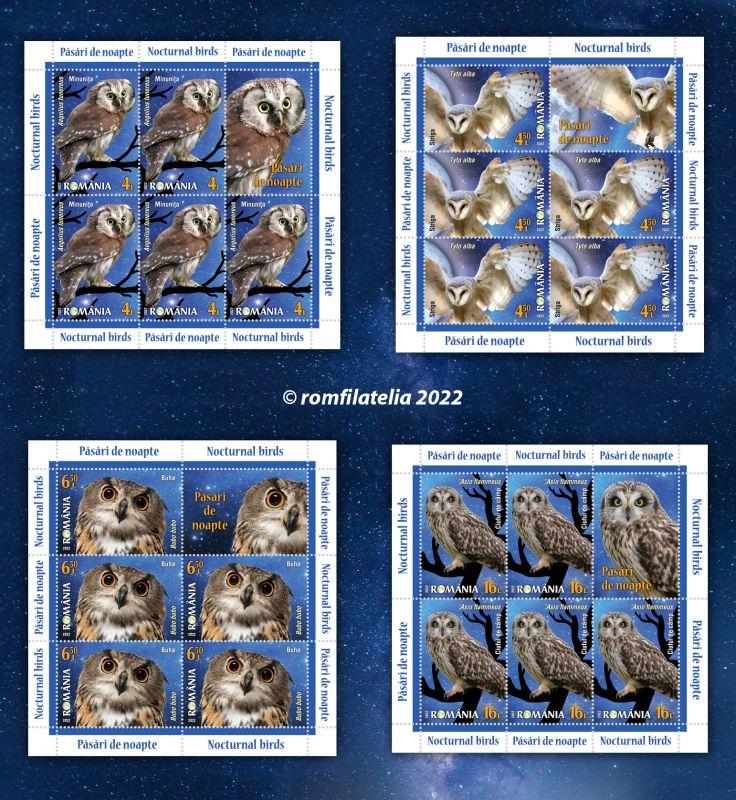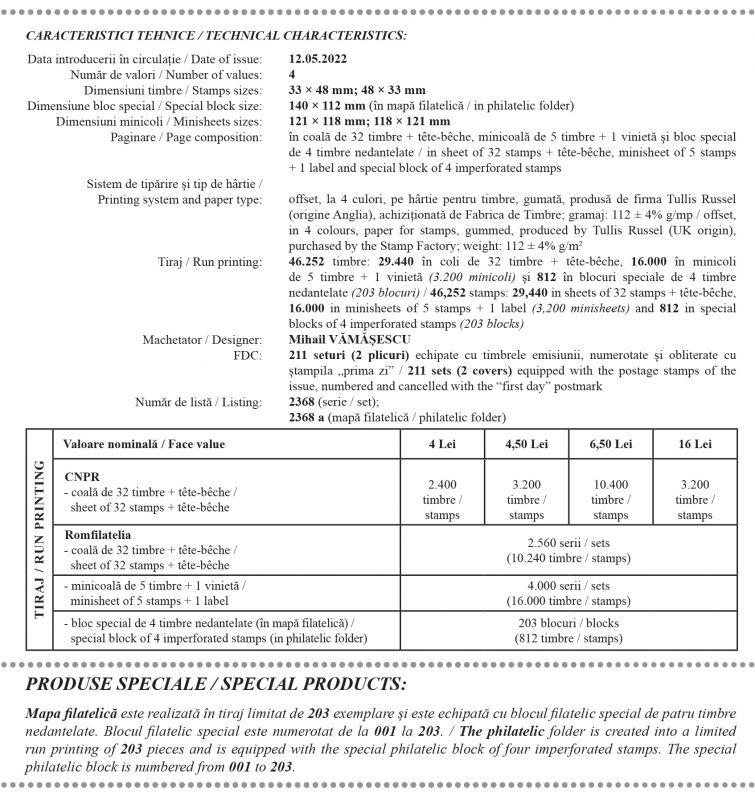 Romfilatelia continues the series of postage stamps issues dedicate dto “Fauna” topic and introduces into circulation, on Thursday, May 12th, this year, the issue entitled Nocturnal birds.
Romfilatelia continues the series of postage stamps issues dedicate dto “Fauna” topic and introduces into circulation, on Thursday, May 12th, this year, the issue entitled Nocturnal birds.
The issue approaches, in the images of the postage stamps, four species of birds of prey, also found in the faunistic treasure of Romania. The design is adapted to the requirements of the specialists in the field, aiming at rendering the defining elements of each species: the shape of the head, the eyes, the plumage, the chromatic aspect, etc. The letter “O” within the word Romania is symbolically rendered as an image of the night star: The Moon.
Boreal owl (Aegolius funereus), illustrated on the stamp with the face value of Lei 4, is characteristic of wooded areas of conifers, but is also present in those mixed with deciduous trees.
The size is similar to the little owl (Athene noctua). The body length is 21-28 cm and weighs 93-139 g for the male and 132-215 g for the female. The wingspan varies from 55-58 cm in males to 59-62 cm in females. Adults have similar appearance. The head is large, with yellow eyes, and the facial expression suggests “wonder”. The plumage is brown on the back, with whitish spots. It feeds on rodents, squirrels, birds and larger insects.
The genus name comes from the Latin word aegolius – screaming owl. The name of the species comes from the Latin word funereus – it announces the funerals of sick people, referring to the belief of many peoples that the cry of owls foretells the death of someone in the house on which they sit.
It is a species present in most of the European continent, in forests whose altitude varies between 400 to 2,000 m. It is solitary and hunts especially at night, sometimes even at sunrise or sunset.
Forest degradation and deforestation are the main threats affecting the species. The implementation of good practice measures in forest management and the installation of artificial nests are a priority.
Barn owl (Tyto alba), depicted on the stamp with the face value of Lei 4.50, is a Medium-sized nocturnal bird of prey. The sexes are similar. The head and back are grey and ellow-brown, and the ventral side is yellow-orange. The eyes are dark, the face is light and with a characteristic heart shape, with a brownish border. The length of the body is 33-39 cm, the wingspan is 80-95 cm, and the weight is 187-455 grams.
The genus name comes from Greek, where Tyto means aurora and the species name, alba, comes from Latin.
The species has a wide, global distribution, being present on all continents except Antarctica. In Romania, the species is widespread throughout the territory, in lowland areas and low hills. In Transylvania, it is present in only a few areas. It is a sedentary species, nesting in Romania.
It is a species living in open and semi-open areas. It nests near agricultural land, both in hollows and in buildings and ruins. It often uses specially mounted artificial box-type nests.
Carnivorous species. Nocturnal and twilight species, it hunts in silent flight, hovering above the ground. It mainly consumes small mammals: rodents (mice, rats, squirrels), shrews; frogs, insects but also small birds.
The main threat is the widespread use of pesticides in agriculture, which leads to a depletion of food resources (insects and rodents). Other threats are severe winters (especially those with heavy snow for long periods, which leads to limited access to food) and persecution by people as a result of superstitions.
Eurasian eagle-owl (Bubo bubo), illustrated on the stamp with the face value of Lei 6.50, is the largest species of night predators in Europe. The sexes are similar (the female being larger). The plumage is dark brown, with broad streaks and black vermiculations on the back. The ventral part is yellowish-brown with broad, black streaks on the chest. The head is large and has long tufts above the ears, which are visible especially when disturbed or singing. The eyes are large, red-orange in colour. The body length is 59-73 cm, the wingspan is 138-170 cm, and the weight is 1,500-2,800 grams for the male and 1,750-4,200 grams for the female.
Both the genus and the species name come from the Latin word bubo, which means owl.
The Eurasian eagle-owl has a wide, Palearctic distribution, being present from the Atlantic Ocean to the Pacific, from sub-tropical to tundra. In Europe, it nests on almost the entire continent,
except in some western and central areas. In Romania, it is present on almost the entire territory, except for the high mountain areas and the south of the country, but it is very fragmented and discreetly distributed. The species nests in Romania, being sedentary.
It is a nocturnal and partly twilight species; given its discreet behaviour, the species is very difficult to locate, although its strong vocalization can be heard from a few kilometres away.
The Eurasian eagle-owl is a monogamous and solitary species; it uses the same nest for several years or by rotation. It nests on inaccessible rock edges, in rock crevices, at the entrance to caves, on the ground under rocks or among rocks. Exceptionally, it uses abandoned nests of birds of prey or barns and abandoned factories.
It is a species extremely sensitive to disturbance, which often leads to nest abandonment. Other threats are the intensive use of pesticides in agriculture, poaching, collisions with power wires and accidents caused by vehicles.
Short-eared owl (Asio flammeus), represented on the stamp with the face value of Lei 16, it is characteristic of open areas represented by pastures, reeds, swamps and agricultural lands. It’s a medium-sized owl. The body length is 33-40 cm and it weighs 206-475 g. The female is larger than the male. The wings are long and narrow, with a wingspan of about 90-105 cm. Adults have a similar appearance, but the male’s plumage is lighter. The head is relatively small and the yellow eyes are bordered by black spots. The plumage is yellow-brownish. It feeds on rodents, rabbits, bats, birds and insects.
The genus name comes from the Latin word asio – night predator with “ears”. The name of the species derives from the Latin word flammea – of flame colour, referring to the bird’s plumage.
It is a species present in most of the European continent. It is active at night, but can also hunt in the twilight or even during the day. It nests on the ground. The nest, represented by a hollow in the ground lined with plant debris and feathers, is made by the female. It uses for feeding a territory between 15 and 200 ha. The known longevity is 22 years. It winters in Africa.
Habitat degradation and destruction, increasing disturbance caused by urbanization and pesticides used in agriculture are the main threats affecting the species. Reducing disturbance and pesticide use is a priority.
Romfilatelia thanks the representatives of the “Grigore Antipa” National Museum of Natural History for the documentary support provided to the development of this postage stamps issue.



